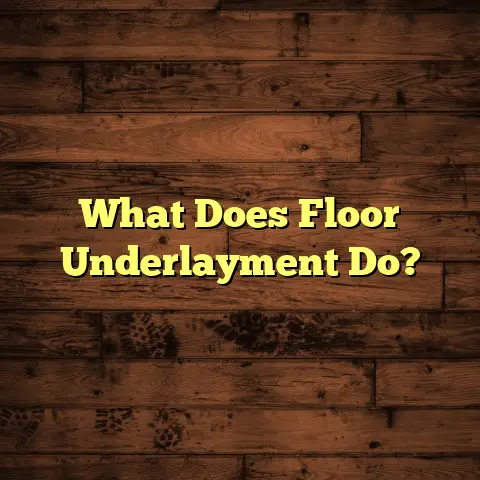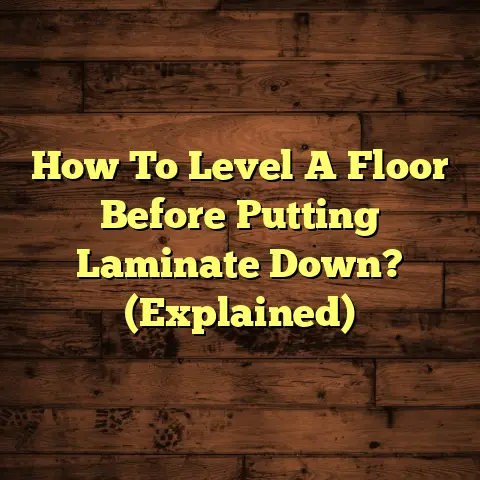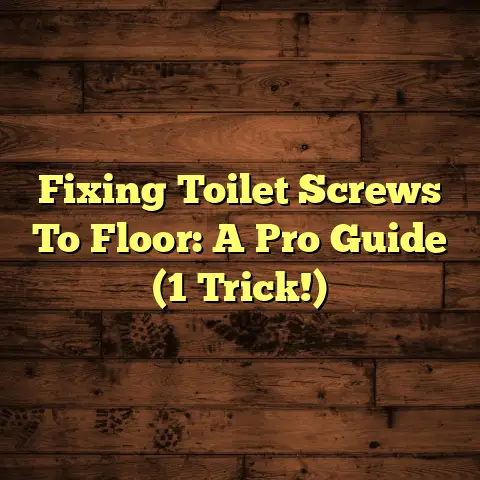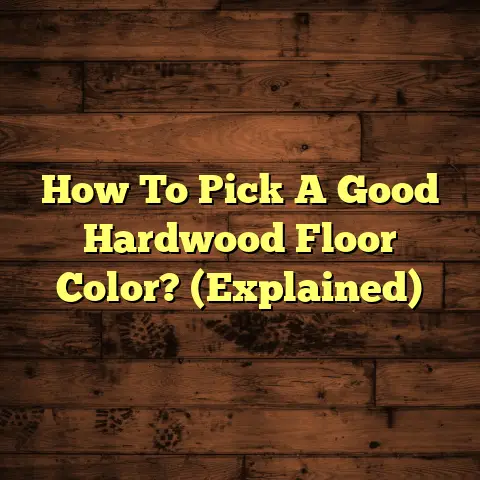Cost To Sand & Finish Floors? (7 Bid Secrets!)
Ever walked into a room and been floored (pun intended!) by the beauty of the hardwood?
That warm, inviting glow?
It’s not just about the wood itself, but the artistry of sanding and finishing.
But here’s the kicker: most homeowners are totally blindsided by the actual cost.
I’ve seen projects where folks thought they’d spend $1,500, only to get hit with a $5,000 bill!
As a flooring contractor with years in the trenches, I’m here to pull back the curtain.
We will unravel the mysteries of floor refinishing costs and reveal the seven secrets contractors often keep close to the vest.
Ready to get started?
Section 1: Understanding the Basics of Sanding
and Finishing Floors
Okay, let’s break down what sanding and finishing really means.
Think of it as a spa day for your floors.
Sanding is like exfoliation – we’re removing the old, worn-out layers of finish and any imperfections.
This creates a smooth, even surface for the new finish to adhere to.
Finishing is like applying a protective coat and makeup – it enhances the wood’s natural beauty, adds durability, and protects it from wear and tear.
Now, what kind of floors are we talking about?
Hardwood: This is the classic choice – oak, maple, walnut, you name it.
Solid hardwood can be sanded and refinished multiple times, making it a long-term investment.Engineered Wood: This has a thin layer of real wood veneer over a plywood or MDF core.
It can be sanded, but usually only once or twice depending on the thickness of the veneer.-
Parquet: These floors have intricate geometric patterns. Sanding them requires extra skill and time.
The process itself involves several steps:
-
Preparation: Clearing the room, removing baseboards, and thoroughly cleaning the floor.
Sanding: Using different grits of sandpaper to remove the old finish and smooth the surface.
This requires specialized equipment like drum sanders, edge sanders, and detail sanders.-
Staining (Optional): Applying a stain to change the color of the wood.
-
Finishing: Applying several coats of polyurethane or other finish to protect the wood and enhance its appearance.
-
Curing: Allowing the finish to dry and harden completely before putting furniture back in the room.
The cost of all this depends on a bunch of factors, including:
-
Floor Condition: Floors with deep scratches, gouges, or water damage will require more extensive sanding and repairs, driving up the cost.
-
Type of Finish: Different finishes have different prices and application requirements.
-
Labor Costs: This varies depending on the contractor’s experience, location, and overhead.
Section 2: The True Cost Breakdown
Alright, let’s get down to the nitty-gritty – the actual numbers.
Keep in mind these are just averages, and your specific project could be higher or lower.
Average Cost Per Square Foot (Sanding and Finishing): Expect to pay anywhere from $3 to $8 per square foot.
This includes labor and basic materials.-
Materials: Stains can add $0.50 to $1.50 per square foot, while sealants can range from $0.30 to $1.00 per square foot.
Here’s a table to illustrate potential cost ranges:
But here’s where things get interesting.
Several variables can send those costs soaring:
Extensive Repairs: If your floors have water damage, rot, or significant gaps, you’ll need to factor in the cost of repairs.
Replacing damaged boards can add $5 to $20 per board.-
Intricate Designs: Parquet floors or floors with inlays require more time and skill to sand and finish, so expect to pay a premium.
-
Difficult Access: If your floors are in a hard-to-reach area, like a small bathroom or a narrow hallway, the contractor may charge more due to the extra effort required.
-
Dust Containment: Opting for a dustless sanding system can add to the cost, but it’s worth it to avoid the mess and health hazards associated with traditional sanding.
Regional Price Variations:
Location, location, location!
Labor costs and material prices vary significantly from one region to another.
For example, you’ll likely pay more for flooring services in a major metropolitan area like New York City or San Francisco than you would in a smaller town in the Midwest.
Local market conditions also play a role.
If there’s a high demand for flooring contractors in your area, prices may be higher due to increased competition.
Section 3: The Seven Bid Secrets
Okay, buckle up, because this is where we get to the good stuff.
These are the secrets that can make or break your flooring project budget.
Secret #1: The Importance of Getting Multiple Quotes
This one’s a no-brainer, but it’s surprising how many people skip this crucial step.
Getting at least three quotes from different contractors is essential for several reasons:
-
Price Comparison: It allows you to see the range of prices in your area and identify any outliers.
Scope of Work: Each contractor may have a slightly different approach to the project, and their quotes should reflect this.
Comparing the scope of work helps you understand what you’re actually paying for.-
Gut Feeling: Meeting with different contractors gives you a chance to assess their professionalism, communication skills, and overall trustworthiness.
How to Evaluate Bids:
Don’t just look at the bottom line.
Pay attention to these factors:
-
Detailed Breakdown: Does the quote include a detailed breakdown of labor, materials, and any additional costs?
Experience: How long has the contractor been in business?
Do they have experience with the type of flooring you have?-
References: Ask for references from previous clients and follow up with them to get their feedback.
-
Insurance and Licensing: Make sure the contractor is properly licensed and insured to protect yourself from liability.
Secret #2: Hidden Costs to Look Out For
This is where things get sneaky.
Some contractors may intentionally leave out certain costs from their initial quote to make it seem more attractive.
Here are some common hidden costs to watch out for:
Furniture Removal: Some contractors may not include the cost of moving furniture in their quote.
Be sure to ask if this is included, or if you’ll need to handle it yourself.-
Baseboard Removal and Replacement: Removing and replacing baseboards can be time-consuming, and some contractors may charge extra for this.
Subfloor Repairs: If your subfloor is damaged, it will need to be repaired before the new finish can be applied.
This can add significantly to the cost of the project.Dust Containment: Traditional sanding creates a lot of dust, which can be a health hazard.
Dustless sanding systems are more expensive, but they’re worth it to avoid the mess and potential health problems.-
Trip Charges: Some contractors may charge a trip charge for each visit to your home.
Always ask for a written quote that includes all costs before you sign any contracts.
Secret #3: Timing Your Project Wisely
Believe it or not, the time of year can impact the cost and availability of flooring contractors.
Peak Season: Spring and summer are typically the busiest times for flooring contractors, as homeowners are eager to get their homes ready for entertaining.
During peak season, you may have to wait longer to get your project scheduled, and prices may be higher due to increased demand.-
Off-Season: Fall and winter are typically slower for flooring contractors, so you may be able to get a better price and more flexible scheduling.
-
Holidays: Avoid scheduling your project around major holidays, as contractors may be unavailable or charge premium rates.
Planning ahead and scheduling your project during the off-season can save you money and ensure that you get the contractor you want.
Secret #4: The Role of Floor Condition in Bids
As I mentioned earlier, the condition of your floors plays a major role in the cost of sanding and finishing.
-
Minor Scratches and Wear: Floors with minor scratches and wear can usually be sanded and finished without any major repairs.
-
Deep Scratches and Gouges: Deeper scratches and gouges may require more aggressive sanding, which can add to the cost.
Water Damage: Water damage can cause wood to warp, rot, or stain.
Repairing water damage can be expensive and time-consuming.Pet Stains: Pet stains can penetrate deep into the wood, making them difficult to remove.
In some cases, the affected boards may need to be replaced.
Be honest with the contractors about the condition of your floors.
Hiding damage or downplaying the extent of the problem will only lead to surprises and additional costs down the road.
Secret #5: Choosing the Right Finish
The type of finish you choose can significantly impact the cost, durability, and appearance of your floors.
The two main types of finish are:
Oil-Based Polyurethane: This is a traditional finish that provides excellent durability and a warm, amber hue.
It’s typically less expensive than water-based polyurethane, but it takes longer to dry and has a strong odor.Water-Based Polyurethane: This is a more eco-friendly option that dries quickly and has a low odor.
It’s also more resistant to yellowing over time.
However, it typically requires more coats than oil-based polyurethane and can be more expensive.
Other Finish Options:
Moisture-Cured Urethane: This is an extremely durable finish that’s often used in commercial settings.
It’s very expensive and requires specialized application techniques.Penetrating Oil Sealers: These sealers penetrate the wood fibers and provide a natural, matte finish.
They’re less durable than polyurethane finishes and require more frequent maintenance.
Consider your lifestyle, budget, and aesthetic preferences when choosing a finish.
Ask the contractors for their recommendations and be sure to weigh the pros and cons of each option.
Secret #6: The Impact of DIY vs. Hiring Professionals
Tackling a sanding and finishing project yourself can save you money upfront, but it’s not for the faint of heart.
Pros of DIY:
-
Cost Savings: You’ll save on labor costs, which can be a significant portion of the total project cost.
-
Control: You have complete control over the project and can work at your own pace.
Cons of DIY:
-
Time Commitment: Sanding and finishing floors is a time-consuming and labor-intensive project.
-
Equipment Costs: You’ll need to rent or buy specialized equipment, such as a drum sander, edge sander, and buffer.
-
Skill and Experience: Sanding floors requires skill and experience to avoid damaging the wood.
-
Potential for Mistakes: Mistakes can be costly to repair and may even require hiring a professional to fix them.
If you’re not experienced with woodworking or home improvement projects, it’s best to leave sanding and finishing to the professionals.
The cost of fixing mistakes can easily outweigh the savings of doing it yourself.
Secret #7: Understanding the Warranty and Service
Agreements
Before you sign any contracts, be sure to carefully review the warranty and service agreements.
Warranty: A warranty protects you against defects in materials or workmanship.
Make sure the warranty covers both the materials and the labor.Service Agreement: A service agreement outlines the contractor’s responsibilities for maintaining the floors after the project is complete.
This may include periodic cleaning, buffing, or re-coating.
Pay attention to the terms and conditions of the warranty and service agreement.
How long does the warranty last?
What is covered?
What is not covered?
What are your responsibilities for maintaining the floors?
A solid warranty and service agreement can save you money in the long run by protecting you against unexpected problems.
Section 4: Conclusion
Alright, we’ve covered a lot of ground!
Let’s recap the key takeaways:
-
Sanding and finishing floors is a complex project with many variables that can affect the cost.
-
Getting multiple quotes is essential for comparing prices and scopes of work.
-
Be aware of hidden costs, such as furniture removal, baseboard replacement, and subfloor repairs.
-
Timing your project wisely can save you money and ensure that you get the contractor you want.
-
The condition of your floors plays a major role in the cost of sanding and finishing.
-
Choosing the right finish is important for durability, appearance, and cost.
-
DIY can save you money upfront, but it’s not for everyone.
-
Understanding the warranty and service agreements can protect you against unexpected problems.
By keeping these seven bid secrets in mind, you can approach your flooring project with confidence and make informed decisions that will save you money and ensure a beautiful, long-lasting result.
Now go forth and conquer those floors!





